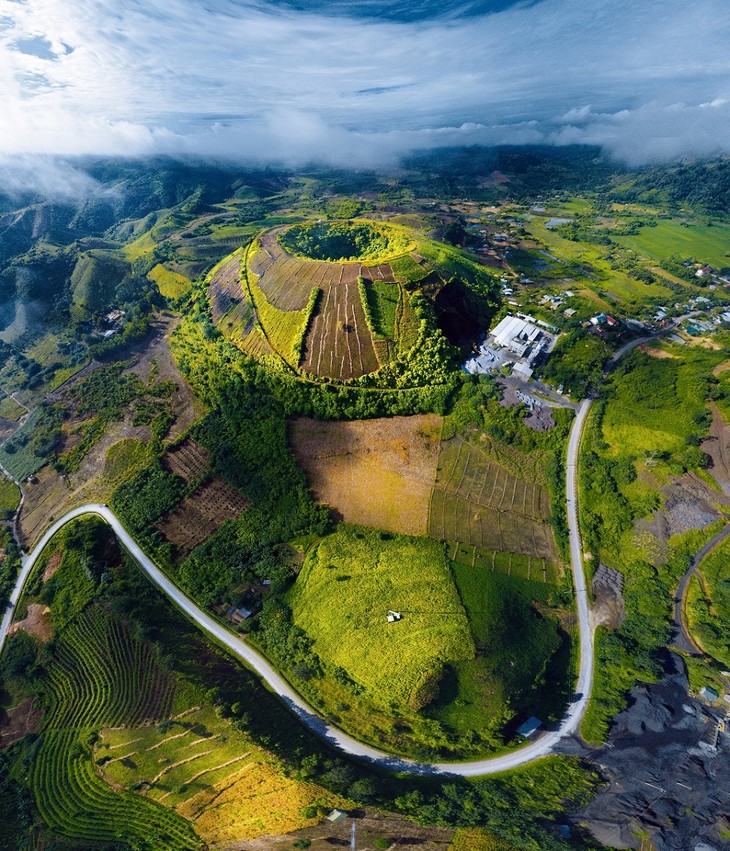(VOVWORLD) - Dak Nong Geopark has just been validated as a member of UNESCO Global Geoparks Network for another four years, until 2027.Endowed with rich cultural traditions and majestic landscapes, the Park has been an attractive destination for domestic and foreign tourists.
 Dak Nong UNESCO Geopark (photo: VOV) Dak Nong UNESCO Geopark (photo: VOV) |
Dak Nong is home to huge waterfalls hidden deeply in forests, including the Dak G’lun, Dray Sap, Gia Long, and Trinh Nu waterfalls, with several volcanic caves, and the Nam Nung Natural Reserve.
The Ta Dung National Park and Ta Dung Lake with nearly 40 islands of various sizes are considered "Ha Long Bay in the Central Highlands".
Dak Nong is inhabited by 40 ethnic groups, who have created a unique cultural space that can only be found in Dak Nong Global Geopark.
Dak Ha commune in Dak Glong district is one of destinations on the “Epic of water and fire” tourof the Geopark. Artisan of rattan weaving craft, K’Bang of the M’Nông group in Ting Wel Dăng hamlet, said community tourism opens a new direction for development. “Traditional craft production has been expanded to serve local consumption demand and sell to tourists. All men in my hamlet can weave rattan products to earn extra income.”
 Inside a volcanic cave in Dak Nong Global Geopark (photo: VOV) Inside a volcanic cave in Dak Nong Global Geopark (photo: VOV) |
On the journey to explore the Dak Nong Global Geopark, tourists will stop at Krong No district to admire nature and people. Y Suo Hlong in Dak Mam town said he is proud of his homeland for its ethnic cultures and famous Dray Sap waterfall and volcanic caves.
“I’m happy that the indigenous cultures and scenic spots, including the Dray Sap waterfall and volcanic caves, are included in the tourism itinerary to contribute to socio-economic development. The villagers are also involved in community tourism and their living conditions have been improved.”
The Mnong people in Nam Nung commune have also involvedin community tourism as a way to preserve and promote traditional culture and earn income. Tourists are invited to experience the local customs, festivals, and lifestyle, and enjoy exotic dishes.
Y Kreu, Deputy Head of Yôk Ju hamlet, said the villagers have established services of homestays, cuisine, and folk culture performances, and cooperatives of brocade weaving and the distilling of liquor in vases.
“We form tourism models to preserve our culture, traditional crafts, and typical dishes of ethnic groups. We serve tourists our home-grown products such as coffee, fruits, and vegetables,” Y Kreu said.
Nam Nung tourism programsofferdiverse experiences of exploring waterfalls and wandering about peaceful rice fields and fruit gardens at the foot of an inactive volcano. H’Thuong, Vice Chairwoman of the Nam Nung commune People’s Committee, cited historical relic sites, natural landscapes, and ethnic cultureas the local advantages. “The biggest advantage for opening community tourism ishaving many artisans playing gongs, making brocade products, weaving rattan, and singing epics. Step by step, they will succeed,” said H'Thuong.
Dak Nong province has identified tourism as one of economic pillars. Investing in tourism, including tours to the Dak Nong Global Geopark, will propel Dak Nong’s tourism globally, said Ton Thi Ngoc Hanh, Vice Chairwoman of the Dak Nong provincial People’s Committee. “We’ve created models to help people understand that they are the entities of heritage preservation and development. Step by step we restore and promote fine traditions and customs of ethnic groups. Cultural preservation serves tourism and contributes to socio-economic development.”
Unique culture, beautiful landscapes, fresh and cool climate all year round, pluswise investment orientations will move Dak Nong’s tourism industry forward and attract more visitors to its UNESCO Global Geopark.